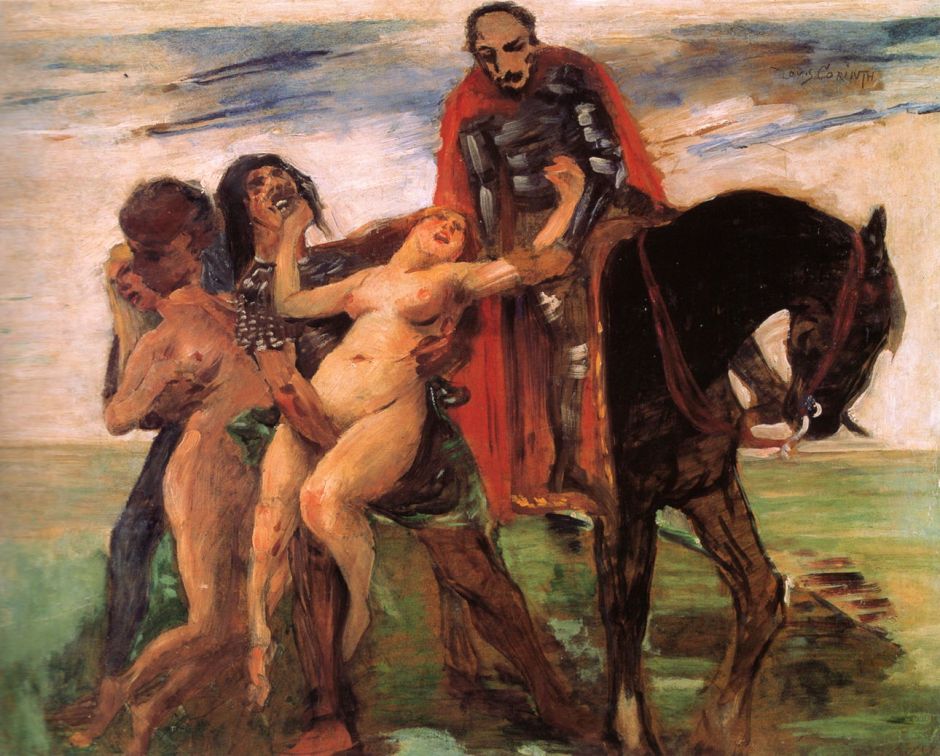With the success of his painting of Salome, and his move to Berlin, Lovis Corinth was reaching the peak of his career. He relished his new-found reputation as ‘the painter of flesh’, and was now at the centre of Germany’s vibrant city of modern arts. In 1902, he opened a painting school for women, and among his first pupils was Charlotte Berend (1880-1967), then just twenty-one and the daughter of a rich textile merchant.
Corinth formally joined the Berlin Secession in 1901, and quickly found himself involved with its direction.

The Family of the Painter Fritz Rumpf (1901) is a wonderfully informal family portrait, which sadly omits Fritz Rumpf (1856-1927) altogether, but Corinth painted him in a separate portrait. The mother, at the right, is Margarethe née Gatterer, and all six of their children are included.
In the summer of 1902, Corinth painted Charlotte for the first time, and the couple travelled to Pomerania together. That autumn they became engaged. Charlotte had already become Corinth’s muse and preferred model, as she was to remain for the rest of his life. That year, Corinth also visited Paris, Anvers, and the Netherlands.

Self portrait with Charlotte Berend-Corinth (1902) is the earliest portrait that he painted of his fiancée and himself. Its original title in German means self-portrait with his wife and a champagne glass although the glass that he is holding clearly doesn’t contain champagne. This refers to Rembrandt’s Self-Portrait with Saskia (The Prodigal Son) (1636), in which Saskia is sat on Rembrandt’s lap, and he raises a large fluted glass of beer in his right hand.
Charlotte, in the role of Saskia, looks quiet and calm, against Corinth/Rembrandt’s alcohol-fuelled mirth.

Swimming in Horst – Ostsee (1902) shows swimmers in the Baltic Sea at what was then known as Horst, and is now the Polish resort of Niechorze.

Presumably Paddling (1902) shows Charlotte’s turn to take to the waters there.
Charlotte Berend and Lovis Corinth married in the spring of 1903. He was 44, she was only 22. In the autumn of the following year, their first child, Thomas, was born, and in 1909 their daughter Wilhelmina.

Self-portrait with Model (1903) is the couple’s second joint portrait, and the first after their marriage. This time her pose refers to the classical images of muses by Rubens and Ingres, alluding to the story of Pygmalion.
Corinth was a left-handed painter, so this image has not been painted directly from a mirror. He may well have used photographs instead.
Max Reinhardt moved to Berlin at the same time as Corinth, and in 1902 his Little Theatre staged what I think was the German premiere of Oscar Wilde’s play Salome. Richard Strauss saw the play there, and it inspired him to write his opera of the same name the following summer.

Corinth painted this wonderful portrait of its star and title role, Gertrud Eysoldt as Salome (1903). This makes an interesting contrast with his 1900 painting of the story. Although during this period he painted fewer mythical and other narrative works, the next painting is, I think, one of his most vivid stories.

Ulysses Fighting the Beggar (1903) shows a story from book 18 of Homer’s Odyssey, before the slaughter of the suitors (painted much earlier by Gustave Moreau, but never completed).
Odysseus/Ulysses has finally returned to his home city of Ithaca and is now determined to kill the many suitors to his wife Penelope. As he plans this, he goes around disguised as a beggar. This fragment of the elaborate story starts with the arrival of a real beggar named Arnaeus or Irus, who most unwisely picks a fight with Odysseus. The hero promptly floors the beggar, stopping just short of killing him.
Corinth captures the fight as Odysseus (centre) is getting the better of Irus (left of centre), with various suitors and bystanders watching. Although painted loosely, the artist has taken care to give each face its own expression, ranging from amusement to apprehension. The end result is a raucous collage of human emotion.

Corinth seems not to have taken this study of abduction, Frauenraub (1904), any further, and I do not know its narrative context.

Landscapes are relatively infrequent over these years, but I could not resist including his delightful Blühender Bauerngarten (Blooming Farm Garden) (1904).

Corinth’s reputation as ‘the painter of flesh’ was maintained by two groups of nudes. The Harem (1904) uses an ever-popular ‘oriental’ setting for an abundance of female flesh, but has some distinctive touches too. The cat sat in the foreground ignores – in the way that only cats can – some sort of horseplay taking place behind, while a guard looks as bored as the cat. This is not the sumptuous silk and divan lounge shown in the nineteenth century, though – indeed, it all looks rather tawdry.

In complete contrast, Charlotte Berend in a Deck Chair (1904) is a tender and intimate sketch of his wife relaxing away from their son, her wedding ring prominent on her left hand.
References
Lemoine S et al. (2008) Lovis Corinth, Musée d’Orsay & RMN. ISBN 978 2 711 85400 4. (In French.)
Czymmek G et al. (2010) German Impressionist Landscape Painting, Liebermann-Corinth-Slevogt, Arnoldsche. ISBN 978 3 89790 321 0.

